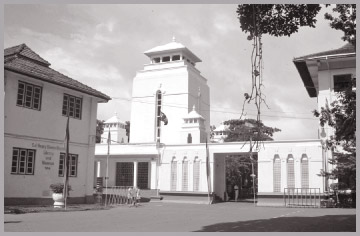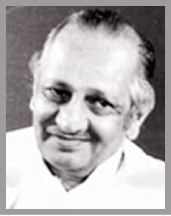Ananda was a symbol of a Buddhist Renaissance
This is a reproduction of an article by
former State Minister Anandatissa de Alwis published in the Daily News
of November 1, 1986
Government considers the centenary of Ananda College as a national
event. This is the only occasion when the centenary of a school has been
so recognised. It may be of some interest to look at the reasons why
such a decision was made. Briefly, Ananda College was the symbol of
Buddhist revival, even, perhaps, the beginning of a renaissance.
 |
|
Ananda
College , Colombo |
Buddhism had been crushed wherever possible by the Portuguese who
ruled the sea-board. Bonfires of temples and texts were commonplace.
Bhikkhus were hunted and murdered. Many of them fled into the safety of
the jungles carrying with them the few texts on Ola leaf. Whole villages
had been terrorised.
This went on for a century and a half. The Dutch who followed
harassed both the Catholics and the Buddhists for another century and a
half, while a small Sinhala Buddhist population continued to live in
freedom in the hill country until eventually even they were overwhelmed
by the British.
American missionaries
By the Convention of 1815 signed in Kandy, the British government had
promised to respect, protect and help the Buddhists and observe their
customs.
The rebellion of 1848 changed this and the British Governors said
that the Buddhists by not keeping to their part of the agreement had
left no choice but to consider the convention no longer in force.
They robbed the lands of the Sinhalese and handed them to British
adventurers who came by every ship. British banks loaned money to these
men who paid a token of about 50 cents for an acre of land. Forced
Indian labour was brought in their thousands and put to work to plant
coffee and later tea and rubber.
The American missionaries arrived and wanted to open schools. They
were tactfully persuaded to go to Jaffna, thus providing the North of
the island a great opportunity of benefiting from mission schools.
The British government needed a school to produce English-educated
people to fill minor posts in the government and mercantile sectors. So
it started Royal College, but the Ceylonese who went to Royal were not
to be denied their opportunity and most of them were brilliant students
in various fields.
Primary levels
They were, however, brainwashed into loyalty to the British King and
Empire. One of President Jayawardene's favourite stories is that his
father who moved a resolution asking for more power to be given to the
Ceylonese ended his speech with the words: “God save the King”. It was
the custom, in those days for speakers to end their orations in that
way!
 |
|
Former
Minister
Anandatissa de Alwis |
The natives were provided education in ‘vernacular’ schools up to
primary levels. Christian missions opened colleges for people of their
faith and Buddhists of affluence were also allowed to send their
children provided students spoke only in English - at least in school.
The rapid decline of Buddhism and the near extinction of the
Sinhalese was at hand until a few began to stand up to the repression.
The Buddhist Theosophical Society, the Mahobodhi Society, the YMBA
movement, the rise of several Bhikkhus with learning and courage began
to revive in the Sinhala Buddhist - a feeling that the thing to do was
to fight back with the same weapon the other had used - education.
Great principals
Into this era of ferment came the famous Colonel Olcott and the
Theosophist Madame Blavatsky. People argue about who started Ananda
College, Olcott? Leadbeater? Blavatsky? Dr W A de Silva? Sir Baron
Jayatilleke?
It was certainly in no way the kind of school anyone would start
today. It was at Maradana (not on the present site) and it as a humble
little building with a few children, but it was a school!
Many argue about who its principals were and claim for this one or
the other the merit of having made Ananda great. Each generation
remembers best the heyday of its youth. It is only natural for instance,
that I should remember Kularatne and Mettananda, as two great principals
of Ananda for I was a student when both these great men were heads of
the school.
There were, however, many others who made substantial contributions
to the character and personality of the college. There were not only the
other principals but members of the staff as well, among whom were
Bhikkhus, the most renowned being Balangoda Ananda Maitriya Maha Thera
who not only taught Buddhism but Raja Yoga meditation as well, to a
small group of volunteers. I was in one of the groups and I treasure a
photograph taken of us with him and Mettananda.
Modern era
There was the late Ven S Mahinda, a Tibetan by birth and is numbered
with the best poets of the modern era. He was supposed to teach Sinhala
but he inflamed us with tales from history in which our ancestors had
fought invaders to the death.
There were teachers like B J Wijemanne who took a group of teenagers
and filled them with courage, toughened them on the parade ground,
motivated them until they beat on equal terms the professional soldiers
of the British garrison at Echelon Barracks and Diyatalawa in the
arduous completion for the Governor's Cup. The victory was a sensation.
Anandians quickly made the grade. It was not a star performance of a
soloist. There was a superb orchestra. In department after department
there grew a feeling of confidence. Anandians learned both English and
Sinhala at equal levels, grade for grade. Thus they read British poets
and literature while they read the Sandesa Kavyas as well. They read
world history as prescribed by the Department of Education - with its
array of British inspectors - but they knew the history of the island as
well. They began to beat the best of the others at cricket and I recall
a photograph published in a school magazine of a team which was not
beaten during the whole school season. The title was ‘The invincible'.
Certain prestigious schools thereafter regretted they had no dates
available to play Ananda.’
Consciousness of nationality
More than these little glories schoolboys and old boys everywhere
love to talk about, the spirit of Ananda was that it spread throughout
the island a new consciousness of nationality. Round Anandians in
cities, towns and villages groups began to grow and those groups became
the flood of opinion on which the political leaders rode to success.
More than half their task of national awakening had been done by Ananda.
Other Buddhist Colleges (Nalanda, Dharmaraja, Ananda Sastralaya and many
many others including schools for Buddhist girls) had clasped hands in
the great revival. Sri Lanka achieved freedom but, more important, the
Buddhist revival was complete.
What of tomorrow? We are in crisis again. To my mind today's crisis
is deadlier than those we faced. The Sinhalese Buddhists are divided.
This division has often been our ruin in the past. It destroyed Kasyapa
of Sigiriya, Sri Jayawardenapura after 200 years of sovereign rule, the
Kandyan Kingdom which survived the Portuguese and the Dutch.Ananda had a
new challenge to face, that of the struggle for power among divisive
groups. Just as a century ago, in the dark sombre day of our country
Ananda led a revival and renaissance, today it must be dedicated to hold
the people together with bonds of unity and patriotism.
|



